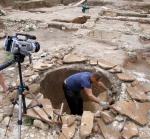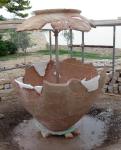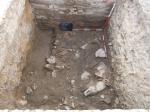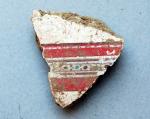Summary (English)
In 2006, excavation was continued on the economic facilities of the Roman villa rustica in Caska. Excavation in 2005 was interrupted due to bad weather conditions at the end of November, and it continued in May 2006. In the residential part of the site, a georadar survey of a smaller scope was also conducted, by which the imposing remains of Roman architecture were recorded. On that area, of approximately 320 m², the excavation continued, and all the layers with traces of human activity were explored. The area was divided into several trenches and quadrants measuring 2 × 2 m.
In the southeastern part of the area (trenches 2 and 3), in addition to three large fragmented dolia discovered in 2005, under a later floor made of solid plaster, three more were found this year. A total of 6 dolia, over 1.5 m in diameter, are placed in two parallel rows suggesting a cella vinaria .
In the northwestern part of the area (trench 4), two square outlines of the walls were observed. Excavations revealed that these were the walls of two basement rooms with a depth of about 2.4 meters. The former storage area gradually became a waste pit with a large amount of diverse archaeological finds.
The infrastructural drain (cloaca) in Trench 1 was completely excavated. It was built from irregular limestone blocks bound with solid plaster, and covered with irregular sandstone slabs. The interior was levelled with limestone plaster, and the floor was paved with tegulae. The outer width of the channel is around 1.25 m, and the height is 1.10 m. The inner width is approximately 40 cm, and the height is 60 cm.
In the area around the dolia, in Trenches 2 and 3, and around the drain in Trench 1, a small number of artefacts were found. Most of them were found in Trench 4, in the excavated basement rooms. Among the metal finds a large number of bronze and iron nails, bronze bucket fittings, several Aucissa fibulae, a zoomorphic fibula with a depiction of a lion with prey, part of a tweezer, and a decorative needle with relief should be singled out. The coins found at the bottom of the basement are the oldest found so far – a half denarius with a depiction of Janus and a sestertius with a depiction of Caesar and Octavian (with a ship’s bow on the reverse). Both coins are from the 1st century BC. With these finds, the range of coins from this site extends from the 1st century BC to the 4th century AD. The most significant group of finds consists of fragments of a large number of amphorae, jugs and glasses, i.e. a repertoire of vessels for storing/keeping and consuming wine. Glasses or cups made of terra sigillata are of exceptional quality. More than 20 workshop stamps were found on them, so it will be possible to determine their origin and trade communications with other parts of the Empire (Goran Skelac 2007, Hrvatski arheološki godišnjak 3/2006, 315–316).
- Goran Skelac
Director
- Goran Skelac
Team
- Silvio Stanković
Research Body
- Geoarheo d.o.o.





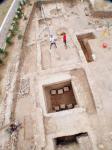
![Download [PDF]](/excavation/skins/fasti/images/results/download_sml.png)
